Earned Value Management in Engineering Projects

Each construction project is unique, but there are three common elements that must always be managed effectively to deliver a project successfully: scope, cost and time. These elements are common to all engineering disciplines; for example, a power plant is very different from a residential high-rise building, but both projects must be defined (scope), scheduled (time) and budgeted (cost).
The Earned Value Method
A common approach to track progress in construction is comparing percentage of work completed against a project plan, but this has a limitation: there is no guarantee that the work completed actually matches the percentage of the budget paid so far. The earned value method (EVM) was developed to account for this, and it is a powerful construction management tool. To understand the EVM, three important concepts must be defined:
- The planned value (PV) is the value of the work that is planned to be completed by a given date, and it is also known as the budgeted cost of work scheduled (BCWS). The PV provides a baseline for project scheduling, encompassing both the percentage of work completed and the incurred cost.
- The earned value (EV) is the value of the work actually completed by a given date, and is also known as the budgeted cost of work performed (BCWP). Since the EV reflects actual progress, it is calculated once per deliverable. By definition, an EV projection is impossible because that would be the PV.
- The actual cost (AC) is the accumulated expense by a given date, and is also known as the actual cost of work performed (ACWP).
The power of the earned value method is that it allows project scope, time and cost to be managed simultaneously. In a project that is being completed exactly according to schedule and budget, these three values are equal. However, this is an ideal scenario that does not occur in real life, and different conclusions can be drawn by comparing the PV, EV and AC.
Planned Value and Earned Value
By comparing these two values, a construction manager can conclude if a project is on time, behind schedule or ahead of schedule:
- If the earned value exceeds the planned value, the project is ahead of schedule.
- On the other hand, if the earned value is below the planned value; the project is lagging behind schedule.
Earned Value and Actual Cost
When these two values are compared, the construction manager can determine if a project is exceeding its budget or being completed for less.
- If the earned value is higher than the actual cost, the project is saving money. The work completed so far has consumed less budget than originally planned.
- If the actual cost is higher than the earned value, the project is exceeding its budget.
Planned Value and Actual Cost
Comparison between these two metrics can be ambiguous, and conclusions can only be drawn if the EV is considered as well.
- The best-case scenario is: Earned Value > Planned Value > Actual Cost. This describes a project that is being completed faster than scheduled and at a cost below the budget.
- The worst-case scenario is Actual Cost > Planned Value > Earned Value. This describes a project that is lagging behind the schedule and exceeding its budget.
Examples: Earned Value Method
The earned value method is much easier to visualize by graphing progress. Assume a project has a total cost of $1,000,000 and there are three intermediate progress reports before completion. According to the project plan, the budget will be consumed as follows:
- Milestone 01 - $400,000 (40%)
- Milestone 02 - $650,000 (65%)
- Milestone 03 - $880,000 (88%)
- Milestone 04 - $1,000,000 (100%)
If these values are graphed, the following result is obtained:
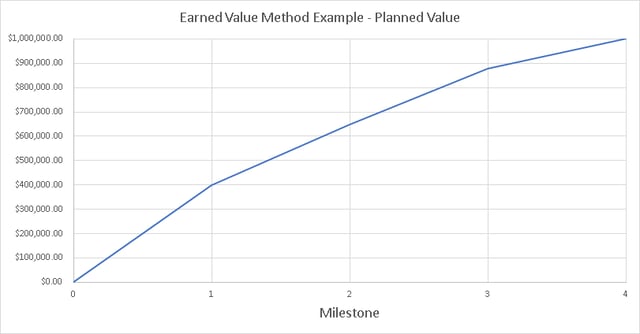
The first progress report is delivered, and following result is obtained:
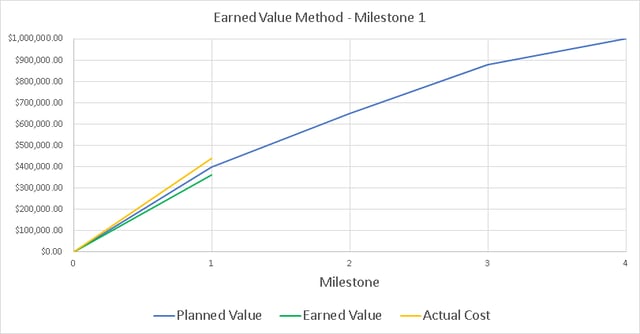
- PV = $400,000
- EV = $360,000
- AC = $440,000
The project is delayed (EV < PV) and going over budget (AC > EV). At this rate, the project will be delivered late and will exceed its total budget.
Corrective action is taken for the second progress report, improving performance:
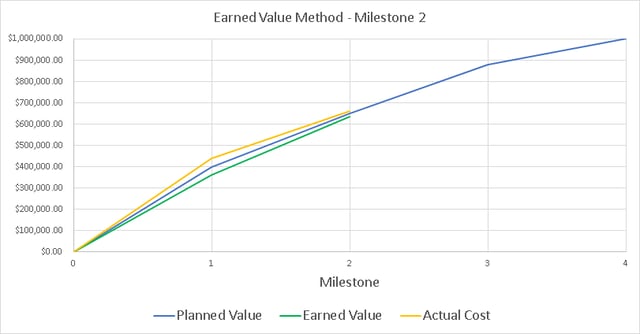
- PV = $650,000
- EV = $635,000
- AC = $660,000
The project is still behind schedule and exceeding its budget, but the gap has been narrowed down. The corrective action taken between Milestones 1 and 2 has been effective.
For the third progress report, the result is the following:
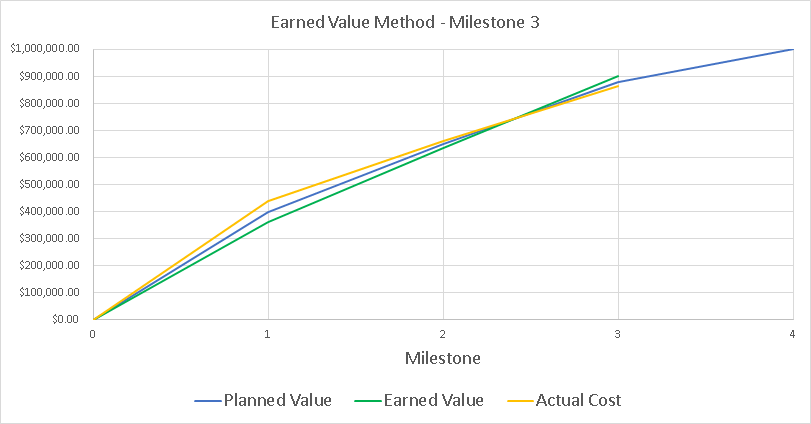
- PV = $880,000
- EV = $900,000
- AC = $865,000
The project is now slightly ahead of schedule, while achieving savings. The final progress report shows a favorable result:
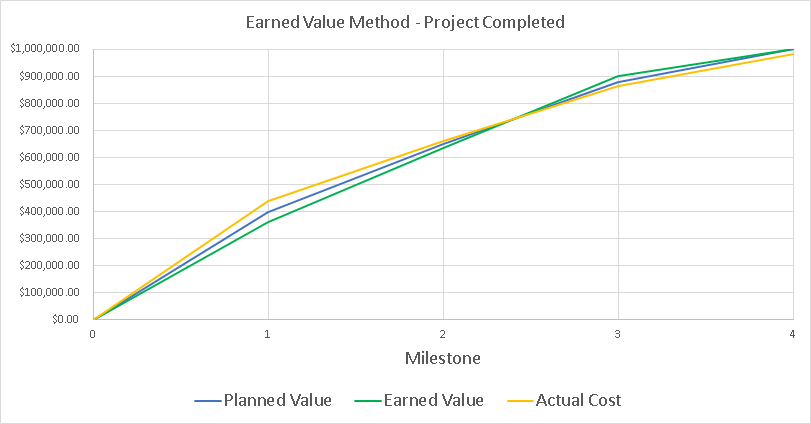
- PV = $1,000,000
- EV = $1,000,000
- AC = $985,000
The project is completed on time and actual expenses are $15,000 below the total budget. Without the earned value method, the performance issue in Milestone 1 would have been more difficult to detect. The construction manager would only know expenses are $40,000 higher than planned - this can be favorable if the project is progressing faster, or unfavorable if the project is exceeding its budget.
Additional Aspects of Construction Administration
Effective construction administration involves completing the project scope within the planned timeframe and without exceeding the budget, but this is only the general picture. There are many other aspects that must be addressed and managed proactively to ensure project success:
- Human Resources
- Communication
- Project Risks
- Procurement
Human Resources
To deliver a project successfully, a team with the right skillset is required. Once the team has been assembled, it must be properly managed so that collaboration and synergy are achieved and maintained. The Project Management Institute breaks down the human resources management process into four key steps:
- Planning: Before a project team is put together, it is necessary to determine the key roles and skills required.
- Acquiring the project team, which involves checking the availability of human resources and possibly hiring external personal temporarily, while the project lasts.
- Team development: Achieving the degree of collaboration necessary to execute the project successfully.
- Team management: Tracking performance, providing follow-up and feedback, and solving issues so that team synergy is maintained throughout the project.
Communications
Projects involve personnel from various professional backgrounds, and often from different companies. Unless communication is planned and managed, misunderstandings and confusion are likely.
Before starting a project, it is necessary to define the types of documents that will be used and their formats, the frequency of meetings and site visits, as well as the communication channels to be used. For every type of document, it is necessary to define who is responsible for generating the file and to whom it must be addressed.
Project Risks
No construction project is free of risks, and the construction administration process must also include a framework to address them. The Project Management Institute provides the following guidelines for the risk management process:
- Risk identification
- Assessment of each risk based on its probability of occurring, and impact in case it occurs. For example, a natural disaster is high-impact and low-probability risk, while delayed equipment deliveries have a much smaller impact but a higher likelihood.
- Determining the response for each risk in case it occurs.
- Risk tracking: reevaluating the impact and probability of each risk throughout the construction process to account for changes in project conditions.
Procurement
Even if a construction project is carried out exclusively by one company, products and services from third parties are normally needed. These products and services have lead times and involve interaction with the internal project staff, which means they must be managed proactively to prevent disruptions to the flow of construction activities. Ideally, each product and service delivered by a third party must be readily available when required by project activities, or the entire construction process may be delayed.
A very important part of procurement is determining when it makes sense to outsource some specific activities. There are cases where the internal staff can carry out a specific activity, but it is more cost-effective to hire a third party, allowing the project staff to focus on higher-priority activities.
Conclusion
The results of a project can be greatly improved with effective construction administration. When there is a reliable framework to track progress and coordinate all aspects of project execution, resources can be used more effectively, with the potential to reduce the total project cost.

Michael Tobias
Michael Tobias, the Founding Principal of NY Engineers, currently leads a team of 150+ MEP/FP engineers and has led over 4,000 projects in the US
Join 15,000+ Fellow Architects and Contractors
Get expert engineering tips straight to your inbox. Subscribe to the NY Engineers Blog below.
